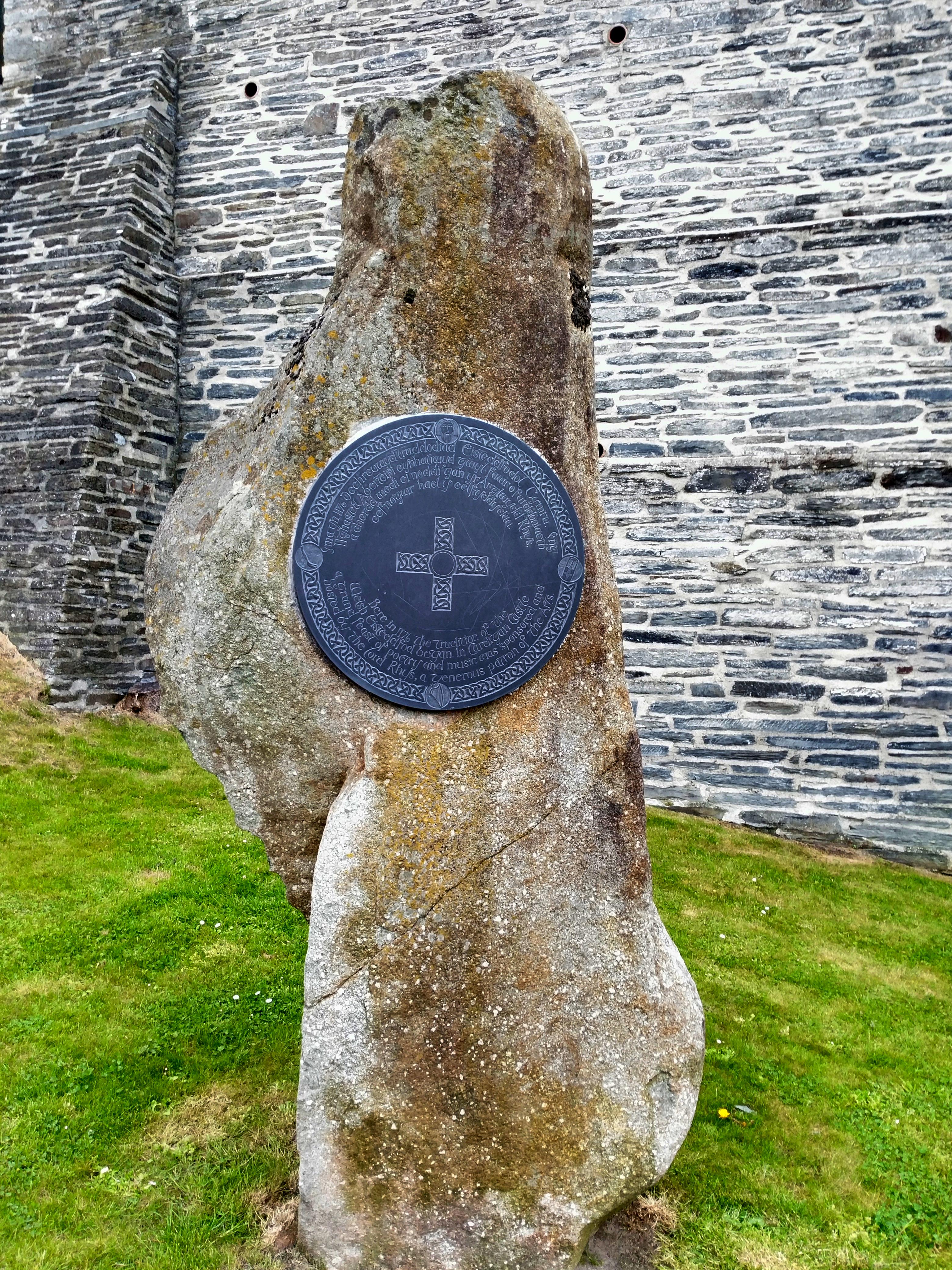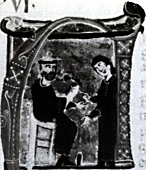|
1176 Cardigan Eisteddfod
The 1176 Cardigan eisteddfod, as it is commonly described, was a cultural tournament involving bards and musicians, held in the grounds of Cardigan Castle, Cardigan, West Wales, by the Lord Rhys ap Gruffydd. Though the term 'Eisteddfodd' was not commonly used until several centuries later, the 1176 gathering is commonly claimed to be the earliest recorded forerunner of the modern national eisteddfod event. Background Rhys ap Gruffydd became the ruler uniting the whole of Deheubarth, covering southwest Wales, in 1155. This had followed years of battles with the English King Henry II. Rhys was made Lord of Ystrad Tywi or, commonly, the Lord Rhys. There followed a period of relative peace and security. In the early 1170s Henry II sought friendship with Rhys and confirmed his leadership of Deheubarth. In 1171 Rhys rebuilt Cardigan Castle in stone, as a political and military statement, making it his chief residence. Welsh princes commonly patronised professional bards at the t ... [...More Info...] [...Related Items...] OR: [Wikipedia] [Google] [Baidu] |
Cardigan Eisteddfod Plaque
Cardigan may refer to: Music * The Cardigans, a Swedish pop group * "Cardigan" (song), a 2020 song by Taylor Swift from ''Folklore'' * "Cardigan", a 2020 song by Don Toliver from '' Heaven or Hell'' Places * Cardigan, Victoria, a region in Australia * Cardigan, Prince Edward Island, Canada ** Cardigan (electoral district), an electoral district in Prince Edward Island * Cardigan, Ceredigion, Wales ** Cardigan (UK Parliament constituency) ** Cardigan Castle ** Cardigan Island, a small uninhabited island north of Cardigan, Ceredigion * Mount Cardigan, a mountain in New Hampshire, U.S. Other uses * Cardigan (sweater), a type of knitted open-front garment * ''Cardigan'' (film), a lost 1922 silent film based on a novel by Robert W. Chambers * Earl of Cardigan, a title in the Peerage of England ** James Brudenell, 7th Earl of Cardigan, British general during the Crimean War after whom the sweater is named * SS ''Bury Hill'' or SS ''Cardigan'', a British steamship See also * C ... [...More Info...] [...Related Items...] OR: [Wikipedia] [Google] [Baidu] |
Brut Y Tywysogion
''Brut y Tywysogion'' ( en, Chronicle of the Princes) is one of the most important primary sources for Welsh history. It is an annalistic chronicle that serves as a continuation of Geoffrey of Monmouth’s ''Historia Regum Britanniae''. ''Brut y Tywysogion'' has survived as several Welsh translations of an original Latin version, which has not itself survived. The most important versions are the one in Robert Vaughan's Peniarth MS. 20 and the slightly less complete one in the Red Book of Hergest. The version entitled '' Brenhinoedd y Saeson'' (''Kings of the English'') combines material from the Welsh annals with material from an English source. The Peniarth MS. 20 version begins in 682 with a record of the death of Cadwaladr and ends in 1332. The entries for the earlier years are brief, usually records of deaths and events such as eclipses, plagues or earthquakes, but later entries are much more detailed. The main focus is on the rulers of the kingdoms of Gwynedd, Powys and ... [...More Info...] [...Related Items...] OR: [Wikipedia] [Google] [Baidu] |
Eisteddfod
In Welsh culture, an ''eisteddfod'' is an institution and festival with several ranked competitions, including in poetry and music. The term ''eisteddfod'', which is formed from the Welsh morphemes: , meaning 'sit', and , meaning 'be', means, according to Hywel Teifi Edwards, "sitting-together." Edwards further defines the earliest form of the eisteddfod as a competitive meeting between bards and minstrels, in which the winner was chosen by a noble or royal patron.Hywel Teifi Edwards (2015), ''The Eisteddfod'', pages 5–6. The first documented instance of such a literary festival and competition took place under the patronage of Prince Rhys ap Gruffudd of the House of Dinefwr at Cardigan Castle in 1176. However, with the loss of Welsh independence at the hands of King Edward I, the closing of the bardic schools, and the Anglicization of the Welsh nobility, it fell into abeyance. The current format owes much to an 18th-century revival, first patronized and overseen by the L ... [...More Info...] [...Related Items...] OR: [Wikipedia] [Google] [Baidu] |
Cultural Festivals In Wales
Culture () is an umbrella term which encompasses the social behavior, institutions, and norms found in human societies, as well as the knowledge, beliefs, arts, laws, customs, capabilities, and habits of the individuals in these groups.Tylor, Edward. (1871). Primitive Culture. Vol 1. New York: J.P. Putnam's Son Culture is often originated from or attributed to a specific region or location. Humans acquire culture through the learning processes of enculturation and socialization, which is shown by the diversity of cultures across societies. A cultural norm codifies acceptable conduct in society; it serves as a guideline for behavior, dress, language, and demeanor in a situation, which serves as a template for expectations in a social group. Accepting only a monoculture in a social group can bear risks, just as a single species can wither in the face of environmental change, for lack of functional responses to the change. Thus in military culture, valor is counted a typical be ... [...More Info...] [...Related Items...] OR: [Wikipedia] [Google] [Baidu] |
Wales Online
Media Wales Ltd. is a publishing company based in Cardiff, Wales. As of 2009 it was owned by Reach plc (formerly known as the Trinity Mirror Group). It was previously known as the Western Mail & Echo Ltd. History The ''Western Mail'' was founded in 1869 by the 3rd Marquess of Bute as a Conservative newspaper. In 1893, the original building in St. Mary Street was destroyed by fire and a new building was opened also in St Mary Street two years later. In 1928 the Western Mail Ltd amalgamated with David Duncan & Sons, who published the ''South Wales Daily News'' and the ''South Wales Echo'', which was established in 1884. The merged company became Western Mail and Echo Ltd. and because of the merger ''Evening Express'' and ''South Wales Daily'' News closed. In 1960, the newspapers left St Mary Street and moved to Thomson House, Cardiff. On 1 October 2007 Western Mail and Echo Ltd changed its name to Media Wales, and in 2008 Media Wales moved from Thomson House in Havelock Str ... [...More Info...] [...Related Items...] OR: [Wikipedia] [Google] [Baidu] |
Flintshire
, settlement_type = County , image_skyline = , image_alt = , image_caption = , image_flag = , image_shield = Arms of Flintshire County Council.svg , shield_size = 100px , shield_alt = , shield_link = , image_blank_emblem = , blank_emblem_alt = , image_map = File: Flintshire UK location map.svg , map_alt = , map_caption = Flintshire shown within Wales , coordinates = , subdivision_type = Sovereign state , subdivision_name = , subdivision_type1 = Constituent country , subdivision_type2 = Preserved county , subdivision_name1 = , subdivision_name2 = Clwyd , established_title ... [...More Info...] [...Related Items...] OR: [Wikipedia] [Google] [Baidu] |
Gruffudd Ap Nicolas
Gruffudd ap Nicolas or Gruffudd ap Nicholas (fl. ca. 1425–1456) was a powerful nobleman in Carmarthenshire, Wales. He organised several bardic eisteddfods in the county during the 1450s. Background Gruffudd is believed to be the son of Nicolas ap Phylip ap Syr Elidir Ddu and his wife, Jennet, daughter of Gruffydd ap Llewelyn Foethus. However, it is not until 1425 that Gruffudd is first recorded, as the king's approver for the lordship and town of Dynevor. By 1436 he was sheriff of Carmarthenshire. By 1439 he was farmer of the lordship of Dynevor, together with his son John. By 1438 Gruffudd was a feared man, according to a petition to the English parliament by Margaret Malefant. Malefant had been so desperate to escape that, in her haste she had sped across South Wales into the arms of a man, so fast that he imagined to "ravysshe ye seide Margaret, and to have hure to hes wyf". A 17th-century history of his family describes Gruffudd's character, saying he was "hott, firie, a ... [...More Info...] [...Related Items...] OR: [Wikipedia] [Google] [Baidu] |
Norman French
Norman or Norman French (, french: Normand, Guernésiais: , Jèrriais: ) is a Romance language which can be classified as one of the Oïl languages along with French, Picard and Walloon. The name "Norman French" is sometimes used to describe not only the Norman language, but also the administrative languages of ''Anglo-Norman'' and ''Law French'' used in England. For the most part, the written forms of Norman and modern French are mutually intelligible. This intelligibility was largely caused by the Norman language's planned adaptation to French orthography (writing). History When Norse Vikings from modern day Scandinavia arrived in Neustria, in the western part of the then Kingdom of the Franks, and settled the land that became known as Normandy, these North-Germanic–speaking people came to live among a local Gallo-Romance–speaking population. In time, the communities converged, so that ''Normandy'' continued to form the name of the region while the original Norse ... [...More Info...] [...Related Items...] OR: [Wikipedia] [Google] [Baidu] |
Puy (society)
A ''puy'' or ''pui'' was a society, often organised as a guild or confraternity, sometimes along religious (Catholic) lines, for the patronisation of music and poetry, typically through the holding of competitions. The term ''puy'' derives from the Latin ''podium'', meaning "a place to stand", referring probably to a raised platform from which either the contests delivered their works or the judges listened to them. ''Puys'' were established in many cities in northern and central France, the Low Countries, and even England during the High Middle Ages and the Renaissance, usually encouraging composition in the Old French language, but also in Latin and Occitan. The typical ''puy'' was dedicated to the Virgin Mary. Membership was regulated by statutes to which those entering had to swear. These governed the election of executive positions within the ''puy'' and the benefits inhering in members. Members could be clerical or lay, male or female, noble or bourgeois, urban or rural. The e ... [...More Info...] [...Related Items...] OR: [Wikipedia] [Google] [Baidu] |
Gwynedd
Gwynedd (; ) is a county and preserved county (latter with differing boundaries; includes the Isle of Anglesey) in the north-west of Wales. It shares borders with Powys, Conwy County Borough, Denbighshire, Anglesey over the Menai Strait, and Ceredigion over the River Dyfi. The scenic Llŷn Peninsula and most of Snowdonia National Park are in Gwynedd. Bangor is the home of Bangor University. As a local government area, it is the second largest in Wales in terms of land area and also one of the most sparsely populated. A majority of the population is Welsh-speaking. ''Gwynedd'' also refers to being one of the preserved counties of Wales, covering the two local government areas of Gwynedd and Anglesey. Named after the old Kingdom of Gwynedd, both culturally and historically, ''Gwynedd'' can also be used for most of North Wales, such as the area that was policed by the Gwynedd Constabulary. The current area is , with a population of 121,874 as measured in the 2011 Census. Et ... [...More Info...] [...Related Items...] OR: [Wikipedia] [Google] [Baidu] |
Dinefwr Castle
Dinefwr Castle (also known as Old Dynevor Castle) is a ruined castle overlooking the River Towy near the town of Llandeilo, Carmarthenshire, Wales. It lies on a ridge on the northern bank of the Towy, with a steep drop of one hundred feet to the river. Dinefwr was the chief seat of the Kingdom of Deheubarth. The castle is a Grade I listed building. Description The present castle is entered via a fortified entrance protected by a restored length of battlement. The short path from the car park gives an extensive view of the Towy valley. The door admits the visitor to the main space enclosed by the walls, from which there are several stairs to the main battlements and towers. A narrow spiral staircase leads to a high tower, which gives extensive views of the deer park to the north and the Towy valley to the south and west. The castle keep is entered via the cellar at its base, but access to the circular walkway at the top can only be made via the battlement walk. Details such as th ... [...More Info...] [...Related Items...] OR: [Wikipedia] [Google] [Baidu] |
Carmarthen
Carmarthen (, RP: ; cy, Caerfyrddin , "Merlin's fort" or "Sea-town fort") is the county town of Carmarthenshire and a community in Wales, lying on the River Towy. north of its estuary in Carmarthen Bay. The population was 14,185 in 2011, down from 15,854 in 2001, but gauged at 16,285 in 2019. It has a claim to be the oldest town in Wales – ''Old Carmarthen'' and ''New Carmarthen'' became one borough in 1546. It was the most populous borough in Wales in the 16th–18th centuries, described by William Camden as "chief citie of the country". Growth stagnated by the mid-19th century as new settlements developed in the South Wales Coalfield. History Early history When Britannia was a Roman province, Carmarthen was the civitas capital of the Demetae tribe, known as Moridunum ("Sea Fort"). It is possibly the oldest town in Wales, recorded by Ptolemy and in the Antonine Itinerary. The Roman fort is believed to date from about AD 75. A Roman coin hoard was found nearby in 20 ... [...More Info...] [...Related Items...] OR: [Wikipedia] [Google] [Baidu] |

.jpg)





